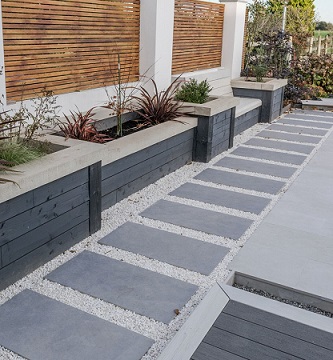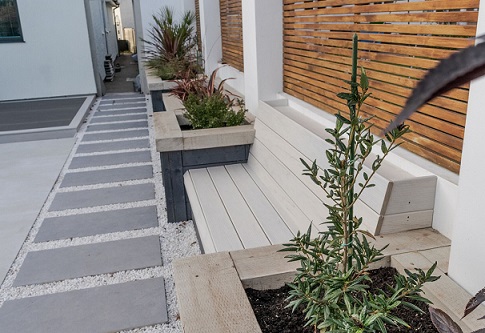This is PrimaPorcelain’s guide to installing a 'Loose Lay' stepping stone path in your garden. It is quick, easy and will enhance any outdoor space visually and practically, giving you year-round access to areas that may get muddy in the winter.

Your stepping stone garden path can be made using porcelain paving slabs you have left over from a bigger project, or you can order PrimaPorcelain outdoor paving specifically for this purpose – either way, it is easily achievable even for a novice and your finished path will be truly stunning.
What you’ll need:
- Straight edge spade
- Rubber mallet
- Straight edge or spirit level
- Brush
- Gloves (optional)
- Small bags of sharp sand
STEP ONE – Setting Out:
Plan your path before digging. Lay out your porcelain slabs to determine the ideal spacing and curve if needed.
STEP TWO – Digging Out:
Using the slab as a template, use the spade to cut around the slab.
The slabs are 20mm thick so you will need to cut down into the ground by around 50mm. This will create a thin sand bed and will help ensure the slab sits slightly below the level of the grass to allow a lawn mower to pass over safely. Please note: If laying the slabs in gravel or shingle, dig a shallower hole to allow the slab to sit slightly proud of the loose material.

STEP THREE – Laying Out:
Pour a thin bed of sharp sand into the hole making sure you spread it into all corners evenly, leaving a fairly flat surface.
Carefully place the slab in the hole, gently tap with the rubber mallet to ensure the slab is settled on the sand. Then use a straight edge or spirit level to determine the slab is laid perfectly flat. Fill the gaps around the edges with sand, and finally brush the slab clear of sand. This process can be repeated if movement occurs once the path is finished.
STEP FOUR – Enjoyment and Maintenance:
Your pathway should be very low-maintenance but occasionally a slab may work its way loose, especially in areas of the garden that hold water, step three can be repeated here.
Laying your path into a cement bed:
The PrimaPorcelain installation team recommend that if you want to lay these stepping stones into a cement bed you need to follow these steps but dig out approximately 50mm deeper to allow for the sand cement bed and use an SBR Bonding agent in the cement mix. They also recommend covering the back of the tile fully with the cement mix rather than the dot/dab method.
To view our range of porcelain paving, click here. Or if you’d like to speak to a member of our team about having a stepping stone path installed as part of your garden project, click here.
Did you know, we now offer large and small porcelain tile samples? Once you've picked your favourite porcelain paving, use our paving calculator to work out how many pavers you need & order directly through the website. We can't wait to help you transform your garden!